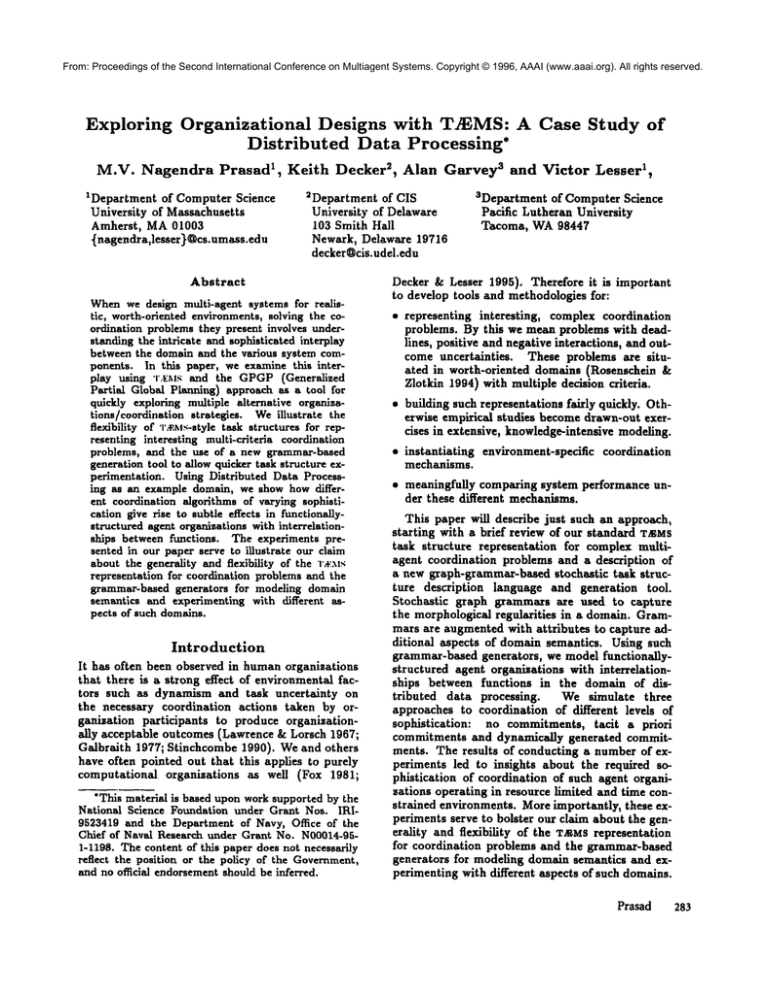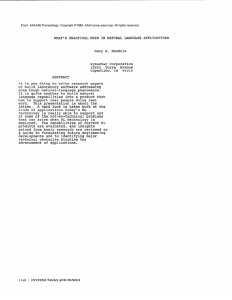
From: Proceedings of the Second International Conference on Multiagent Systems. Copyright © 1996, AAAI (www.aaai.org). All rights reserved.
Exploring
Organizational
Designs with T.1EMS: A Case Study of
Distributed Data Processing*
M.V. Nagendra
Prasad
1,
1Department of Computer Science
University of Massachusetts
Amherst, MA01003
~nagendra,lesser}@cs.umass.edu
Keith
Decker s,
Alan
Garvey a 1,
and
~Department of CIS
University of Delaware
103 Smith Hall
Newark, Delaware 19716
decker@cis.udel.edu
Abstract
Whenwe design multl-agent systems for realistic, worth-oriented environments, solving the coordination problemsthey present involves understanding the intricate and sophisticated interplay
between the domain and the various system components. In this paper, we examine this interplay using ",’:E,~I.~ and the GPGP(Generalized
Partial Global Planning) approach as a tool for
quickly exploring multlple alternative organizations/coordination strategies. Weillustrate the
flexibility of "r.~M~-styletask structures for representing interesting multi-criteria coordination
problems, and the use of a new grammar-based
generation tool to allow quicker task structure experimentation. Using Distributed Data Processing as an example domain, we show how different coordination algorithms of varying sophistication give rise to subtle effects in functionallystructured agent organizations with interrelationships between functions. The experiments presented in our paper serve to illustrate our claim
about the generality and flexibility of the I’~:.~!~
representation for coordination problems and the
grammar-based generators for modeling domain
semantics and experimenting with different aspects of such domains.
Introduction
It has often been observed in humanorganizations
that there is a strong effect of environmental factors such as dynamism and task uncertainty on
the necessary coordination actions taken by organisation participants to produce organisationany acceptable outcomes (Lawrence & Lorsch 1967;
Galbraith 1977; Stinchcombe 1990). Weand others
have often pointed out that this applies to purely
computational organizations as well (Fox 1981;
*This material is based upon work supported by Lhe
National Science Foundation under Grant Nos. IB.19523419and the Department of Navy, Office of" the
Chief of Naval Research under Grant No. N00014-951-1198. The content of this paper does not necessarily
reflect the position or the policy of the Government,
and no ofllcial endorsementshould be inferred.
Victor
Lesser
3Department of Computer Science
Pacific Lutheran University
Tacoma, WA98447
Decker & Lesser 1995). Therefore it is important
to develop tools and methodologies for:
¯ representing interesting,
complex coordination
problems. By this we mean problems with deadlines, positive and negative interactions, and outcome uncertainties.
These problems are situated in worth-oriented domains (Rosenschein
Zlotkin 1994) with multiple decision criteria.
¯ building such representations fairly quickly. Otherwise empirical studies becomedrawn-out exercises in extensive, knowledge-intensive modeling.
¯ instantiating environment-specific coordination
mechanisms.
¯ meaningfully comparing system performance under these different mechanisms.
This paper will describe just such an approach,
starting with a brief review of our standard T/BMS
task structure representation for complex multiagent coordination problems and a description of
a new graph-grammar-based stochastic task structure description language and generation tool.
Stochastic graph grammars are used to capture
the morphological regularities in a domain. Grammars are augmented with attributes to capture additional aspects of domain semantics. Using such
grammar-based generators, we model functionallystructured agent organizations with interrelationships between functions in the domain of distributed data processing.
We simulate three
approaches to coordination of different levels of
sophistication:
no commitments, tacit a priori
commitments and dynamically generated commitments. The results of conducting a number of experiments led to insights about the required sophistication of coordination of such agent organizations operating in resource limited and time constrained environments. More importantly, these experiments serve to bolster our claim about the generality and flexibility of the TraMSrepresentation
for coordination problems and the grammar-based
generators for modeling domain semantics and experimenting with different aspects of such domains.
Prasad
283
From: Proceedings of the Second International Conference on Multiagent Systems. Copyright © 1996, AAAI (www.aaai.org). All rights reserved.
T.IEMS: Task Analysis,
Environment
Modeling,
and Simulation
The T.~MS framework (Task Analysis, Environment
Modeling, and Simulation) (Decker & Lesser 1993;
Decker 1995) represents coordination problems in
a formal, domain-independent way. In the simplest
terms, a TAMSmodel of a task environment specifies what actions are available to agents and how
those actions relate to one another and to the performance of the system as a whole. Wehave used
it to represent coordination problems in distributed
sensor networks, hospital patient scheduling, airport resource managementsdistributed information
retrieval, pilot’s associate, local area networkdiagnosis, etc. (Decker 1995). T~gMSmodels problemsolving activities of intelligent agents operating in
complex environments where:
¯ Responses to some tasks are required by specific
deadlines.
¯ The problem-solving environment involves a
worth-oriented domain (Rosenschein & Zlotkin
1994). In a worth-oriented domain goals are encoded as functions that rate the acceptability of
states, and the agents strive for the best solution possible (but not necessarily an optimal solution). Weuse the term quality to refer to all
acceptability characteristics other than temporal
characteristics.
¯ Optimal performance on individual computational tasks may not be possible due to missing
or incomplete information, or lack of processing
time.
¯ Agents may concurrently
contribute
to the
achievement of multiple goals involving potentially different subsets of agents. The computational results from multiple agents may need to
be integrated to form a complete solution.
¯ Subproblems are interdependent, that is, cannot
be solved independently in isolation.
One implication of the deadline requirement is
that the representation must specify when there are
multiple ways to accomplish a goal that trade off
the time to produce a result for the quality (acceptability) of the result. The possibility of incomplete
or missing information will, by necessity, lead to
agents working in a satisficing modein which problem solving is structured to operate effectively even
with missing information. For this reason, the representation includes what we will call "soft" coordination relationships that define the implications, in
terms of both result quality and computation duration, of specific information arriving prior to the
start of the computational task. Additionally, the
effect of an agent’s activities maynot be quantifiable from a local perspective; instead it mayneed
to be measured from the perspective of howit contributes to the solution of a high-level goal. Thus,
284
ICMAS-96
there needs to be a representation of howprogress
towards the achievement of a goal occurs incrementally as the result of multiple activities. Finally,
the representation of agent activity should allow
for the possibility that individual agent’s activities
contribute to different and independent high-level
goals.
Td~MS models
Wewill present a brief summaryof the objective
(external environment) definition of T~MSmodels.
Interested readers will find manymore details and
examples in (Decker 1995). The following description is top-down, starting with the environment and
ending with what the agent perceives. Thus we do
not define a coordination problem until the final
subsection. TAMSmodels are discrete state-based
models, where the state of all agents in the system
at time t -t- 1 is computedfrom their state at all
previous times.
An environment ¢Y is a generator function that
takes arbitrary set of parameters (including the
set of agents), and produces episodes E. This is
done according to the generative model for the specific environment; this paper will discuss a new
grammar-based generator. An episode is a particular identifiable collection of problem instances-later in this paper we will be looking at an episode
as a collection of problems that occur at a distributed data processing center over the course of
one full day.
Wewill nowdescribe the objective task structure
of a problem-solving episode. An episode E consists of a set of task groupsT; E : (7"1, 7-2,..., 7"~).
Each task group has an arrival time Ar(T), and
deadline D(T). A task group represents a set
computationally related actions. A task group is
represented by a directed acyclic graph. The nodes
of the graph are called tasks T. One task is denoted the root task, and is usually simply indicated
by the symbol for the entire task group, T. Tasks
that have no children are called ezecutable methods, or just methods M for short. Tasks that do
have children, but that are not the root task, are
straightforwardly called subtasks. The structure of
a task group is meant to reflect the problem’s task
structure.
The edges of this graph form the subtask relationship. Task or task group quality at a given
time (Q(T,t)) is based on subt ask rela tionship. This quality function is constructed recursively. Formally, the subtask relationship is defined as subtask(T, T, Q), where T is the set of all
direct subtasks of T and Q is a quality function
Q(T, t) : [tasks x times] ~-~ [quality] that returns
the quality associated with T at time t. The quality
accrual semantics of a particular environment are
modeled by the appropriate choice of the quality
function Q (e.g., minimum, maximum,summation,
From: Proceedings of the Second International Conference on Multiagent Systems. Copyright © 1996, AAAI (www.aaai.org). All rights reserved.
or the arithmetic mean). In particular, we will often write of the quality achieved at a task group at
time t, Q(T, t), meaning the current quality at the
root task.
Executable methods represent domain actions,
like executing a blackboard knowledgesource, running an instantlated plan, or executing a piece of
code with its data. Executable methods have several functions defined on them. q(M, t) is the current mazimumquality that can be achieved by executing Mat time t for its duration d(M, t). d(M,
is the current duration of method Mat time t.
Progress(M,t) is the number of time units spent
executing M. The definitions of q(M, t), d(M,
and Progress(M, t) are fixed by T~MS. Q(M, t) iS
the quality at Mat time t. This function is available for modeling a particular environment, but it
is constrained to obey the identity:
Q(M, t) q(M, $)
if [Progress(M, t) = d(M,t)] A [Finish(M) _<
(i.e. the quality is the maximum
quality if the executable method was completed before its deadline).
Any task T containing a method that starts executing before the execution of another method
Mfinishes may potentially affect M~s execution
through a non-local effect e. Wewrite this relation (a labeled arc in the task structure graph)
ale(T, M, e, pl,p~,...),
where the p’s are parameters specific to a class of effects. There are precisely two possible outcomes of the application of
a non-local effect on Munder our model: duration effects where d(M, t) (duration) is changed
and quality effects where q(M, t) (maximumquality) is changed. Aneffect class e is thus a function
e(T, M, t, d, q, Px,P2,...) :[task x methodx time x
duration x quality x parameter 1 x parameter 2 x
...] ~-~ [duration × quality].
Each method has an initial
maximumquality
q0(M) and duration d0(M) so we define q(M,
q0(M) and d(M, 0) = d0(M). If there is
one non-local effect with M as a consequent
ale(T, M,e, Px,Pz,...), then [d(M, t), q(M, t)]
e(T,M,t,d(M,t1),q(M,t1),px,p2,...).
there is more than one non-local effect, then the
effects are applied one after the other in an order
specified in the model. Wehave defined at least
sixteen example non-local effects (Decker 1995).
Wecan define a performance measure 7~(E) for
the system (or for an agent) that is a function
the episode. The default is the sum of the task
group qualities (7~(E) = ~"~T~. Q(7", D(T))).
can also define a control function (alternately,
"strategy", decision rule, or control policy) for each
agent that given the agent’s current beliefs and the
time will return the action that the agent should
take at that time. One statement of a cooperative
coordinated control problem (similar in spirit to the
specification of a team theory decision problem) is
then to find a set of such control functions, one
for each agent in an environment, so as to attempt
to maximize the expected performance measure for
the entire system of agents.
Grammar-based
Generation
Task
Structure
Decker and Lesser(Decker 1995; Decker & Lesser
1995) illustrate
the importance of extensive empirical studies in determining the role of different
coordination algorithms in different task environments. However, these studies relied on a weak
task environment generator where the experimenter
was limited to setting certain numerical parameters
like mean of the task structure depth or mean and
variance of the numberof interrelationships in task
structures. This often gives rise to a wide range of
task structures and a huge variance in the types of
capabilities needed by the system to effectively handle them. Moreimportantly, it is unlikely that most
reed applications involve an infinite variety of task
structures. The domain semantics dictate and limit
morphology of the task structures. While there is
bound to be some randomness in these structures,
it is highly unlikely that the only regularity that
can be modeled in the task structure representations of a coordination problem instance are a few
parameters like its mean depth or branching factor. Below we introduce a graph grammar based
task structure specification language that is powerful enough to model the topological relationships
occurring in task structures representing manyreal
life applications. Wefirst briefly introduce graph
grammars (GGs) and our extensions to traditional
graph grammars to capture domain semantics beyond the topological relationships.
Wethen show
how a data-flow mode] of data processing can be
captured by task structures and their grammatical
specifications.
Graph Grammars Graph grammars are a powerful tool used in a number of domalns(Mullins
Riuderle 1991; Nagi 19"(9) to capture and characterize the underlying structural regularities. They
offer a structured way of describing topological relationships between entities in a domain. Graph
grammars are fundamentally similar to string
grammars(Chomsky1966; Nagl 1979) with the difference lying in the productions. A graph production is a triple p = (gl,gr,£) wheregt is the subgraph
to be replaced (left hand side) and g, is the subgraph to be inserted in its place in the host graph.
E is the embedding transformation. A number of
schemes for graph grammar have been proposed
and the primary differences between them arise
from the differences in the embedding schemes.
Muchof the traditional literature in graph grammars does not deal with attribute valued nodes
and edges and stochastic productions. Weneed attributes to capture a number of other aspects of
Prasad
285
From: Proceedings of the Second International Conference on Multiagent Systems. Copyright © 1996, AAAI (www.aaai.org). All rights reserved.
domainsemantics in addition to the topological relationships between entities. Stochasticity in the
productions adds more power to the modeling potential of these grammars by capturing aspects of
uncertainty in the domain. Accordingly, we call our
grammars Attribute Stochastic Graph Grammars
(ASGGs).
Let a graph G = (V,E),where V is the set
of vertices
(alsoreferred
to as nodes)andE
the set of edges.Nodesand edgescan havelabels. An AttributeStochasticGraph Grammar
is defined as a 8-tuple (En, An, Et, At, A, Aa, S, P)
where the nonterminal node alphabet (r.,~),
the
terminal node alphabet (~’.¢), and the edge-label
alphabet(A) are finite, non-empty, mutually disjoint sets, An, A¢, and Aa are the respective sets of
attributes, S E r-n is the start label (can be a node
or a graph) and P is a finite nonemptyset of graph
production rules(Sanfeliu & Fu 1983). A graph production is a 4-tuple Pi = (g~,g~, £s Pr(pi)} where
E P,(pJ)
= 11 P and a,e isomorphic)
°
Let G be a graph derived from S using P. Rewriting this graph involves what is called a LEARRE
method(Mullins & Rinderle 1991): Locate a subgraph gO that is isomorphic to the lefthand side,
g~ of production p~ E P, establish the Embedding
Area in G°, Removegl along with all the edges incident on it, Replace g~ with g~ and E_mbedit to
the host graph Go - gO. Figure 1 shows a simple
example.
Prmluttion
s~
a~
Embcddmg:
COtlIIC¢! i,~.ic(C) Io llci~hhorq A)
(.’OIIIICt.’l flodt’(CIo
ill ti~zhhol’~| I) I
{.’onnccl nodc(I)l Ii, m..i~hlxlrMIll
Re~rile
©--®
Figure 1: Example of a Graph GrammarRewriting
The rewriting stops when every node label is
in the terminal alphabet set P’t and the resultant graph is considered a memberof the family
of graphs generated by the ASGG.For the sake of
expository clarity the exampledoesn’t deal with attributes. Distributed data processing examples in
the next section will showinstances of attributes.
Another extension to our definition of graph
286
ICMAS-96
grammars involves partial edges. A production embedding can specify a link between a local label
and non-local label (in the host graph) that may
be non-existent at the time of the application of
the production. This "hanging" edge gets linked
if and when a node with the corresponding label
arises at a later time due to rewriting in the host
graph. If the termination graph is reached without
a node with the corresponding label, this hanging
edge is removedat that point.
ASGGs and Distrlbuted
Data Process|ng
Our example of a functional agent organisation is
derived from the domain of distributed data processing (DDP) that involves a number of geographically dispersed data processing centers (agents).
Each center is responsible for conducting certain
types of analysis tasks on streams of satellite data
arriving at its site: "routine analysis" that needs to
be performed on data comin8 in at regular intervals
during the day, high priority "crisis analysis" that
arises due to the stochastic occurrence of certain
~ thatarises
events
and"lowpriority
analysis
atthe
beginning
of thedaywitha probability.
Lowpriorityanalysis
involves
performing
specialised
analysis
on specific
archival
data.Different
centers
needto
perform different kinds of tasks for a given type of
analysis. Different types of analysis tasks have different priorities. A center should first attend to the
"crisis analysis tasks ~ and then perform "routine
tasks" on the data. Time permitting, it can handle the low-priority tasks. The processing centers
have limited resources to conduct their analysis on
the incoming data and they have to do this within
certain deadlines. Results of processing data at a
center may need to be communicatedto other centers due the interrelationships
between the tasks
at these centers. For example, in order begin analyzing a particular stream of satellite data, a center mayneed the results of a related analysis from
another center. The question that we considered
was whether appropriate coordination among centers could be provided by (1) a fairly simple dataflow driven coordination algorithm, by (2) precomputed standard operating plans, or whether (3)
more complex but time-consuming algorithm using
non-local commitments was necessary.
We used the GPGP approach(Decker
& Lesser
1995;Decker1995)to modelthesethreedifferent
coordination
algorithms
of varying
sophistication.
We firstdiscuss
howa dataprocessing
problem
can
be represented
as a T~M$taskstructure
and how
ASGGscan be usedto represent
domainsemantics
of a dataprocessing
problem.
In thefollowing
discussion
dataprocessing
centerandagentareused
interchangeably.
Figure2a showsthedataflowrepresentation
of
an example
DP problem.
It consists
of threetasks:
Tx, Ts, and Ts. T1 facilitates Ts, and Ts enables Ts.
From: Proceedings of the Second International Conference on Multiagent Systems. Copyright © 1996, AAAI (www.aaai.org). All rights reserved.
"Facilitates" is a soft interrelationship which says
that if the results of processing task Tx axe available
at T2 when it starts processing, then the duration
of the method for achieving Tz is reduced and its
quality is increased. "Enables" is a hard interrelationship that implies that the results of processing
T2 must be available at Ts before it can start processing.
A T)gMSrepresentation of the same problem can
be seen in Figure 2b. The leaves of the task structure show available methods for the tasks. Figure 3
shows a graph grammar for this task structure. To
avoid cluttering, not all attributes are shownin the
figure. There are a number of attributes like the
quality accrual function, termination time, earliest start time for tasks, and type, duration, quality, deadline, termination time, etc. for methods.
The quality and duration attributes of a method
are specified as distributions representing certain
aspects of uncertainty in the underlying domains.
This feature of the grammar leads to a large variety of semantically different task structures but
their structural variety is limited by the graph productions.
Q
jo~
AIIdhUl~:
OualilyA~:L’I’ualFn¯ Max
Pr.thahilJly
: I.(I
Aiz,:la~’r(h : A~.m~Sf)
Apall~t$2J U
ALICliI~($’4
D~adliJIr~5
1 i = D.’udlil~l.S
|
Q
:~
l~nlhcd:
t~8111ct~
T I ta~liCipltl~rM
~I I
@
Embed:
ClmhL~t
T21,J itL’i/atihi~r~4
%2J
:=
~
Figure 2: Example of a Data Processing problem
and its T~EMSrepresentation
Wemodeled the DDPdomain using three graph
grammars, each one generating task structures representing the type of operations that need to be
performed on the incoming data. A grammar is
activated at regular intervals (representing arrival
times for data) with a probability corresponding
to its type. For example, the low priority task
structure grammar is activated with probability
"low_priority_tasks_probability_parameter" only if
the time is 0 (beginning of the day). Achieving
all crisis tasks gets higher final quality than routine tasks and achieving routine tasks gets higher
quality than low priority tasks. The task deadlines
are basically determined by the policies at a center
and they represent the amount of processing time
available to a center to process the data it sees. Figure 4 showsthe interrelationships of the three types
of processing tasks we investigated in the following experiments. The tasks are distributed across
agents as shown by the rectangles demarcating the
(~,ILtXP.imlI~JL’J
II :’71’. ~¢:’L}
{~tnalil~lM
[|Im
agents.
it Ks~llil~
] )F1)
u: D:tta flow
L111~1
T~lcJ nci~llha~.~3 )
AflrJhuIt:~
Figure 3: Example of a Graph GrammarRewriting
LT
b: TAEMS
Task Stmcturt.
F~’d:
k, nFD
h: Cri~
¢: L~~rx~ily DR’
Figure 4: Data Processing Problems
Instantiating
Environment-speclfic
Coordination
Mechanisms
In order to bring to bear different collections
of coordination mechanisms for different multiagent problem-solving environments, we use the
Generalized Partial Global Planning (GPGP) approach(Decker & Lesser 1995; Decker 1995). The
GPGPapproach consists of an extendable set of
modular coordination mechanisms, any subset or
all of which can be used in response to a particular task environment. This approach has several
unique features:
¯ Each mechanismis defined as a response to certain features in the current subjective task environment. Each mechanism can be removed entirely, or parameterized so that it is only active
for some portion of an episode. Newmechanisms
can be easily defined.
¯ The GPGP coordination
component works by
supplying information and constraints to the
Prasad
287
From: Proceedings of the Second International Conference on Multiagent Systems. Copyright © 1996, AAAI (www.aaai.org). All rights reserved.
local scheduler, and to other agent’s coordination components. The most common constraint is a commitment(Cohen& Levesque 1990;
Jennings 1993) to achieve a certain level of quality at a task by a certain time. The empirical resuits in this paper were achieved using a ’designto-time’ soft real-time local scheduler developed
by Garvey (Garvey & Lesser 1995).
¯ GPGPis characterized by its use of commitments
as a powerful and flexible way to achieve domain
independent coordination among agents.
The coordination module in GPGPconsists of
several coordination mechanisms, each of which notices certain features in the task structures locally
known, and responds by taking certain communication or information gathering actions, or by proposing new commitments. The coordination
module keeps track of local commitments and commitments received from other agents, and chooses from
amongmultiple schedules if the local scheduler returns multiple schedules.
The important point is that we can use the flexibility of the GPGPapproach to easily introduce
new coordination mechanismsfor different environments. By usingthe T~Ms-basedsimulatorand
GPGPtogether,
we can derivea betterempirical
understanding
of whattheeffectof different
coordination
mechanisms
is on important
performance
characteristics
in a problem
solving
environment.
Thisgivesus a powerful
toolforposingandansweringquestions
aboutcoordination
and organizationof multi-agent
systems
in complex
environments.
In thenextsection,
we willusethesetools
to exploretheDistributed
DataProcessing
environment.
Specifically
we willbe investigating
the
effect
of threecoordination
algorithms
in thisdomain:
I. Data Flow Algorithm:An agentcommunicates
theresult
of performing
a taskto alltheagents
andtheotheragents
canexploit
theseresults
if
theystillcan.Thereare no commitments
from
anyagent
toanyotheragent.
Inthecaseoffacilitatesinterrelationships,
theresults
needtoarrive
before
thestart
ofthefacilitated
task.
Ifa recipientagenthasa taskthatis enabled
by theresult,
itcanstartexecuting
itonlyafter
receiving
thatresult.
In theGPGPapproach,
thesecharacteristics
canbe obtained
by turning
offallcoordination
relationship
exploitation
mechanisms,
turningon non-local
viewdetection
and communication
ofallresults.
2. Modular(or
dynamic-scheduling)
represents
the
otherextremewhereagentscoordinate
through
commitmentsand relevantresultsthat arc
committedto otheragentsare communicated.
Agentsschedule
dynamically
tryingto exploit
as bestas possible
theinterdependencies
among
tasks.The agentshavethe relevant
non-local
288
ICMAS-96
3.
view of the coordination problem, detect coordination relationships,
form commitments and
communicate the committed results.
Rough coordination is similar to modular but
commitments do not arise out of communication between agents. Each agent has an approximate idea of when the other agents complete their tasks and communicateresults based
on its past experience. "Rough commitments"
are a form of tacit social contract between agents
about the completion times of their tasks. However, it is unrealistic to expect the commitments
on low probability crisis tasks and low priority
tasks to follow such tacit a priori rough commitments. So this coordination type uses rough
commitments for routine tasks but behaves just
like data flow for the non-routine crisis and low
priority tasks. The agents have the relevant nonlocal view of the coordination problem, detect
coordination relationships, but use rough commitments for routine tasks and communicate the
committed results. It might be possible to view
rough commitments as precompiled social laws
(Shoham& Tennenholtz
1992).
Experiments
Weperformed a series of experiments varying a
numberof parameters in our modelto see the effectiveness of different coordination mechanismsused
to managethe activities at different centers. The
experiments reported below study the performance
of the three coordination algorithms discussed previously.
Effect of Crisis Tasks
The probability of the centers seeing crisis tasks
was varied from 0 to 1.0 as shownin Table 1. Each
cell in the table shows quality averaged over 100
runs at the particular parameter settings. Lowpriority tasks arrived with a probability of 0.5 and
the routine tasks were always seen at the time of
new arrivals. The deadline was fixed at 140 time
units for these experiments. At lower values of crisis tasks probability (0.0 and 0.1) , modular performed better than both rough and data flow (significantly better using the Wilcoxon matched-pair
signed-ranks test at significance level 0.05). However, as the probability increases rough and data
flow algorithms perform significantly better at crisis
tasks probability 1.0. This initially looked counter
intuitive to us but a closer examination of the runs
revealed the reasons. The commitment mechanisms
implemented as of now in GPGPare "one-way".
There are commitments from the predecessor end
of the interrelations to the agents at the successor
end but not the other way. For example, agent AI
commitsto doing T1 of the crisis task structure (see
Figure 4b) by a certain time and agent A2 tries
From: Proceedings of the Second International Conference on Multiagent Systems. Copyright © 1996, AAAI (www.aaai.org). All rights reserved.
to take this commitment into consideration while
scheduling for its crisis tasks. However,there are no
commitments from agent Aa about the latest time
it needs the results of execution of task T2 so that it
can schedule its methods. This results in Agent A2
trying to take advantage of commitments from A1
and in the process sometimes delaying execution of
its methodsuntil it is too late for agent As to execute its methods enabled by the results from A2.
These experiments lead us to an important general
observation that just being sophisticated may not
guarantee better performance of a coordination algorithm. It has to be sufficiently and appropriately
sophisticated--in
this case, commitments need to
flow in both directions between predecessors and
successors. Otherwise, the coordination algorithm
may not only be wasteful in computation and communication resources but it may also lead to inappropriate behavior.
Crisis TG
Probability
0.O
0.1
0.5
1.0
Data Flow
0
64.2
’243.1
437.4
Modular ] Rough
147.6
164.5
282.5
406.1
91.5
149.9
295.2
439.77
Table 1: Average Quality for deadline 140
Effect
of Deadlines
Weran another set of experiments with deadline
being varied. The crisis tasks probability was set
to 0.1 and low priority tasks probability was set
to 0.5. Newroutine tasks were always seen at the
time of new data arrival. The results of these experiments are shown in Table 2 where each cell in
the table shows quality averaged over 100 runs at
the particular parameter settings. Modular performed significantly better than the other two coordination mechanismsat higher deadlines (140, 200,
300,500). However,muchto our initial surprise, increasing the deadline from 140 time units to 200 led
to a decrease in average quality for both modular
and rough. This arises due certain subtle interactions between the coordination mechanism and the
design-to-time scheduler. Whenthe deadline is 140
time units, agent A2 chooses lower quality methods that have lower durations for performing its
tasks. However, when the deadline increases to 200
time units, it chooses higher quality methodsfor its
schedule of activities. However,since the agents are
coordinated using only predecessor commitments,
Aa now delays its higher duration methods long
enough to adversely effect the ability of Aa to execute its enabled methods by not providing results
in time. As deadline time increases above 200, it
can be seen that the average quality increases again
(more time is available for enabled methods in As
to complete execution).
}Deadline I Data Flow
100
0
120
58.5
140
64.2
200
73.6
220
80.3
300
104.8
500
108.1
I Modular[ RoughI
0
24.8
184.5
124.0
297.5
342.3
378.0
0
27.2
149.9
92.6
214.2
120.0
126.5
Table 2: AverageQuality for for different deadlines
Discussion
The actual results of these experiments are not as
important as the fact that the T~MSrepresentstion with a graph grammar based modeling framework provides a flexible and powerful way to experiment extensively and tease out subtle and intricate interactions between the components of a
complex system, and between the domain and the
system. The importance of such studies, especially
for designers building complex systems, cannot be
overstated.
Our own understanding of the GPGP
family of coordination algorithms (even after working with it for a number of years) has benefited
from such an exercise.
In addition to the experiments discussed above,
we have done a number of other experiments as
well, but we will not discuss them here because
of space. Following are some of the other insights
gleaned from these experiments:
¯ In our experiments, an agent cannot interrupt
the execution of a method once it has begun.
This leads to some severe performance lapses on
the part of the agent because it does not see task
structures for a long time after their arrival - until
it finishes executing the present method. Based
on our observations, we hypothesize that interruptible methodexecution can lead to better performances in this domain.
¯ If the agents can somehowanticipate the task
arrivals (for example, an expert mayforecast the
arrival of tasks based on the activity of the past
few days and his or her past experience), coordinating for them up front can lead to performance
gains for the agents.
Weare currently working to confirm these hypotheses.
Conclusions
This paper has demonstrated the use of representational, experimental, and methodological tools such
Prasad
289
From: Proceedings of the Second International Conference on Multiagent Systems. Copyright © 1996, AAAI (www.aaai.org). All rights reserved.
as T/EMS and GPGPin understanding questions
of multi-agent organizational design. The use of
these tools facilitates easy and powerful exploration
of various coordination strategies for complex and
strategically useful domains. Important highlights
of our approach include the use of
¯ quantitative, hierarchical task structures as a
flexible mechanismfor representing coordination
problems
¯ grammar-based generation techniques for capturing a relevant Udomaintheory" for an environment without extensive knowledge engineering
¯ the generalized partial global planning approach
to constructing environment-centered collections
of coordination mechanisms.
Details about the T~MSrepresentation
and GPGP
can be found in (Decker & Lesser 1993; 1995;
Decker 1995).
In particular, this paper also considered a particular problem, functionally organized Distributed
Data Processing (DDP) in some detail.
We investigated the behavior of three different coordination algorithms for a set of task structures in
DDP. We empirically demonstrated that the lack
of coordination mechanismsfor exploiting the successor side commitments in GPGPled to certain
"unexpected" behaviors for a particular set of data
processing tasks. However, the readers should be
warned against generalizing beyond the set of task
structures investigated. It is entirely conceivable
that a different set of task structures, interrelated
in a different way, can lead to wildly different resuits. On the other hand, the tools provided herein
enable a designer to quickly and effectively model
these new task structures, perform controlled experiments and determine the behavior of various
coordination algorithms in such different environments.
In future, we would like to push this work
in a number of different directions.
Grammarbased generators have been used to study situationspecific learning of coordination algorithms and the
initial results have been promising. Wewould like
to further experiment with such learning in different computational environments. The present set
of experiments have made us painfully aware of the
lack of successor side coordination in GPGP.We
are working to include these mechanisms. In addition, the T~MSframework is being generalized to
explicitly represent uncertainty in quality and duration, cost, and multiple outcomes.
References
Chomsky, N. 1966. Syntactic
and Co.
290
ICMAS-96
Structures.
Mouton
Cohen, P. R., and Levesque, H. J. 1990. Intention
is choice with commitment.Artificial Intelligence
42(3):213-261.
Decker, K. S., and Lesser, V. R. 1993. Quantitative modeling of complex computational task environments. In Proceedings of the Eleventh National
Conference on Artificial Intelligence, 217-224.
Decker, K. S., and Lesser, V. R. 1995. Designing a family of coordination algorithms. In Proceedings of the First International Conference on
Multi-Agent Systems. San Francisco: AAAIPress.
Longer version available as UMassCS-TR94-14.
Decker, K.S. 1995. Environment
Centered
Analysis and Design of Coordination Mechanisms.
Ph.D. Dissertation, University of Massachusetts.
Fox, M. S. 1981. An organizational view of distributed systems. IEEE Transactions on Systems,
Man, and Cybernetics 11(1):70-80.
Galbraith, J. 1977. Organizational Design. Reading, MA:Addison-Wesley.
Garvey, A., and Lesser, V. 1995. Design-to-time
scheduling with uncertainty. CS Technical Report
95-03, University of Massachusetts.
Jennings, N. R. 1993. Commitments and conventions: The foundation of coordination in multiagent systems. The Kno~oledge Engineering Reviet0 8(3):223-250.
Lawrence, P., and Lorsch, J. 1967. Organization
and Environment. Cambridge, MA:Harvard University Press.
Mullins, S., and Rinderle, J. R. 1991. Grammatical Approaches to Engineering Design, part
i. Research in Engineering Design 2:121-135.
Nagl, M. 1979. A Tutorial and Bibliographic Survey on Graph Grammars. In Claus, V.; Ehrig, H.;
and Rosenberg, G., eds., Graph Grammars and
their AppKcation to Computer Science and Biology, LNCS73. Berlin: Springer-Verlag. 70-126.
Rosenschein, J. S., and Zlotkin, G. 1994. Designing conventions for automated negotition. A I
Magazine 29-46.
Sanfeliu, A., and Fu, K. S. 1983. Tree-graph
Grammarsfor Pattern Recognition. In Ehrig, H.;
Nagl, M.; and Rozenberg, G., eds., Graph Grammars and their Application to Computer Science,
LNCS153. Berlin: Springer-Verlag. 349-368.
Shoham, Y., and Tennenholtz, M. 1992. On the
synthesis of useful social laws for artificial agent
societies (preliminary report). In Proceedings of
the Tenth National Conference on Artificial Intelligence, 276-281.
Stinchcomhe, A. L. 1990. Information and Organizations. Berkeley, CA: University of California
Press.





